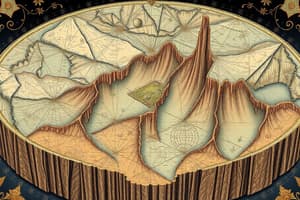Podcast
Questions and Answers
Explain the composition and characteristics of the Earth's crust.
Explain the composition and characteristics of the Earth's crust.
The Earth's crust is composed of large amounts of silicon and aluminum and is the outermost layer of the Earth. It is divided into two types: oceanic and continental. The crust is part of the lithosphere and is made up of plates on which the continents and oceans rest.
What is the lithosphere and how is it related to the Earth's crust and upper mantle?
What is the lithosphere and how is it related to the Earth's crust and upper mantle?
The lithosphere is the zone of rigid, brittle rock made up of the crust and the upper layer of the mantle. It is related to the Earth's crust and upper mantle as they together form the lithosphere, which is divided into separate plates that move slowly in response to the convecting part of the mantle.
Describe the composition and characteristics of the Earth's mantle.
Describe the composition and characteristics of the Earth's mantle.
The mantle is the thickest layer of the Earth, approximately 2900km (1800 miles) thick. It is composed of elements such as magnesium, silicon, oxygen, and iron. The mantle is solid but capable of flow, and its convection currents cause changes on the Earth's surface.
What is the asthenosphere and how does it contribute to the movement of the Earth's lithospheric plates?
What is the asthenosphere and how does it contribute to the movement of the Earth's lithospheric plates?
Explain the role of convection currents in the middle mantle and their impact on the Earth's surface.
Explain the role of convection currents in the middle mantle and their impact on the Earth's surface.
Flashcards are hidden until you start studying
Study Notes
Earth's Crust
- The Earth's crust is the outermost layer, composed mainly of silicate rocks.
- Two types: continental crust (thicker, less dense, primarily granitic rocks) and oceanic crust (thinner, denser, primarily basaltic rocks).
- Average thickness ranges from 5 to 70 kilometers.
Lithosphere
- The lithosphere encompasses the Earth's crust and the uppermost part of the mantle.
- It is rigid and brittle, extending approximately 100 kilometers deep.
- Divided into tectonic plates that move over the softer asthenosphere beneath.
Earth's Mantle
- The mantle lies beneath the crust, extending about 2,900 kilometers deep.
- Composed mainly of silicate minerals rich in iron and magnesium.
- Divided into the upper mantle and lower mantle, with variations in temperature, pressure, and physical properties.
Asthenosphere
- The asthenosphere is a semi-fluid layer located in the upper mantle.
- Extends from about 100 kilometers to 700 kilometers below the surface.
- Facilitates the movement of lithospheric plates due to its plasticity, allowing them to slide and interact.
Convection Currents in the Mantle
- Convection currents occur in the middle mantle, driven by heat from the Earth's core.
- Hotter, less dense material rises, while cooler, denser material sinks.
- These currents create forces that contribute to the movement of tectonic plates, impacting geological activity such as earthquakes and volcanism on the Earth's surface.
Studying That Suits You
Use AI to generate personalized quizzes and flashcards to suit your learning preferences.




